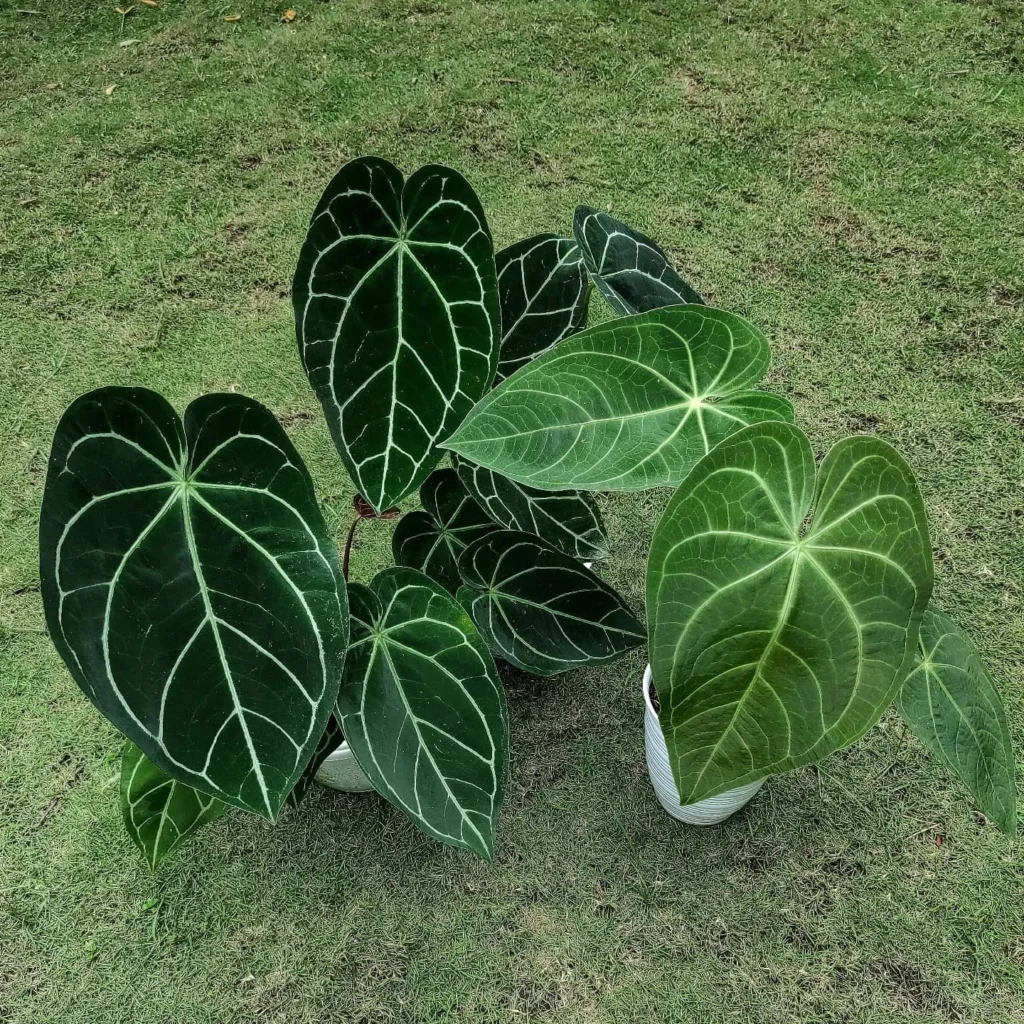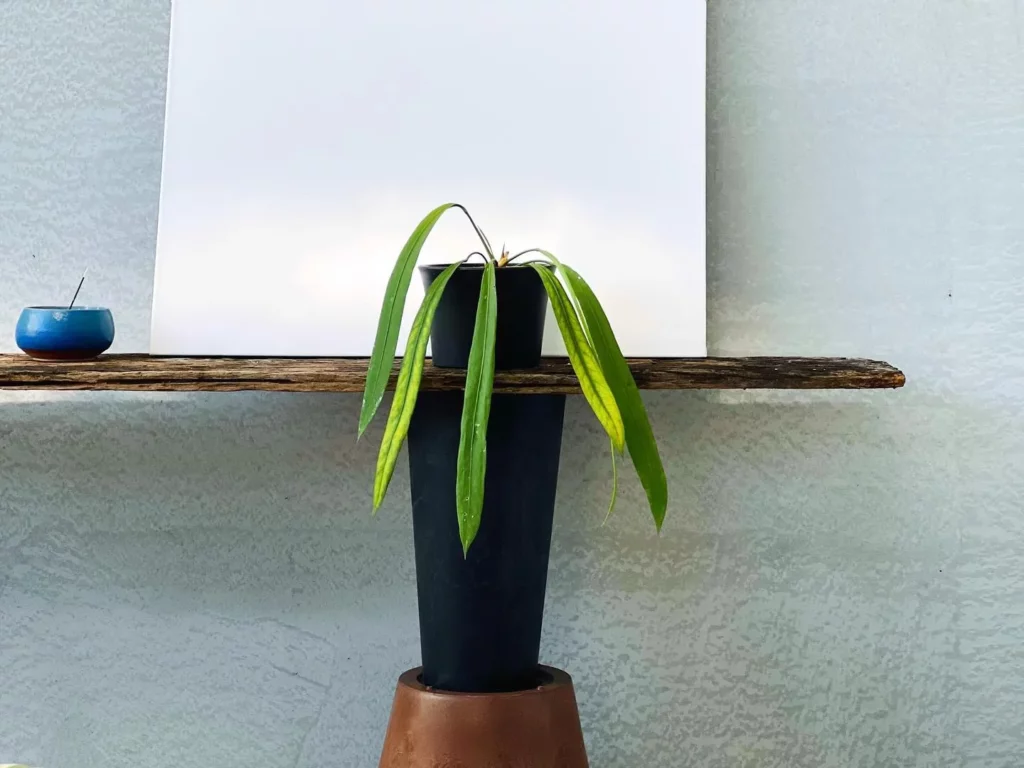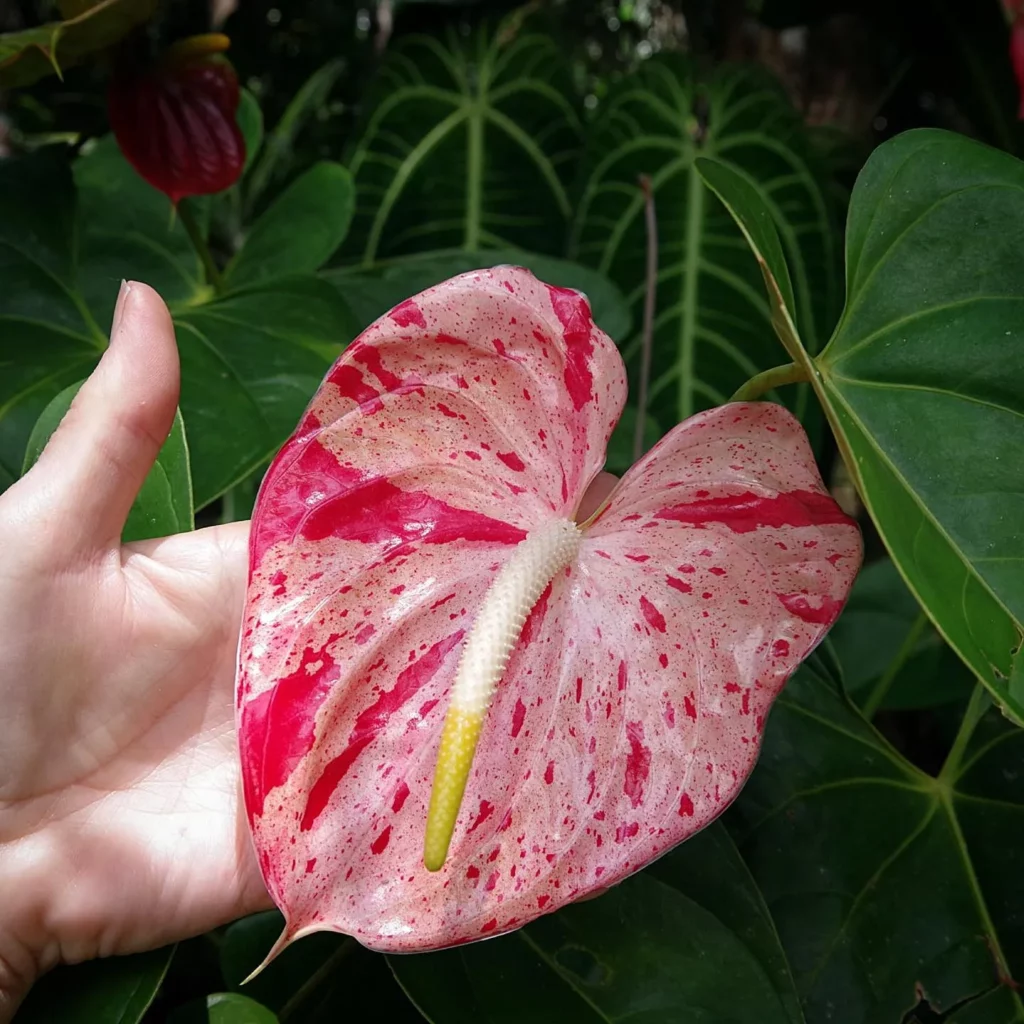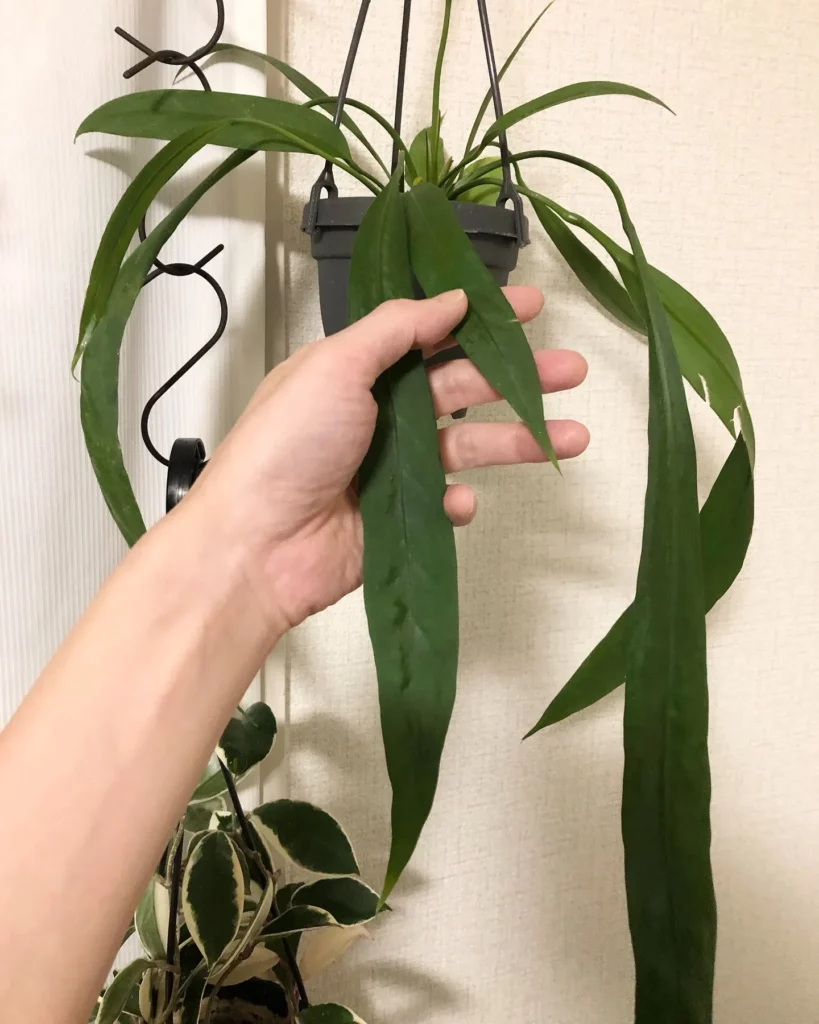Anthurium magnificum, known as the Magnificent Anthurium, is an impressive plant from the Anthurium genus, featuring large leaves up to 3 feet in length and 1 foot in width. Its dark green leaves with prominent veins make it a striking addition to indoor gardens. While it requires specific care, it’s not overly difficult to maintain.
Caring for Anthurium magnificum involves providing ample sunlight and humidity. It thrives under natural light, but artificial lighting can be used in less sunny environments. Watering should be moderate, maintaining moist but not waterlogged soil. Overwatering should be avoided to prevent root issues.
For propagation, seeds or cuttings should be planted in a potting mix enriched with compost. It’s crucial to maintain a temperature above 60 degrees Fahrenheit (15°C), as lower temperatures can halt growth. Once established, Anthurium magnificum can enhance any space with its exotic and elegant appearance, making it a unique choice for plant enthusiasts.
Genus Species
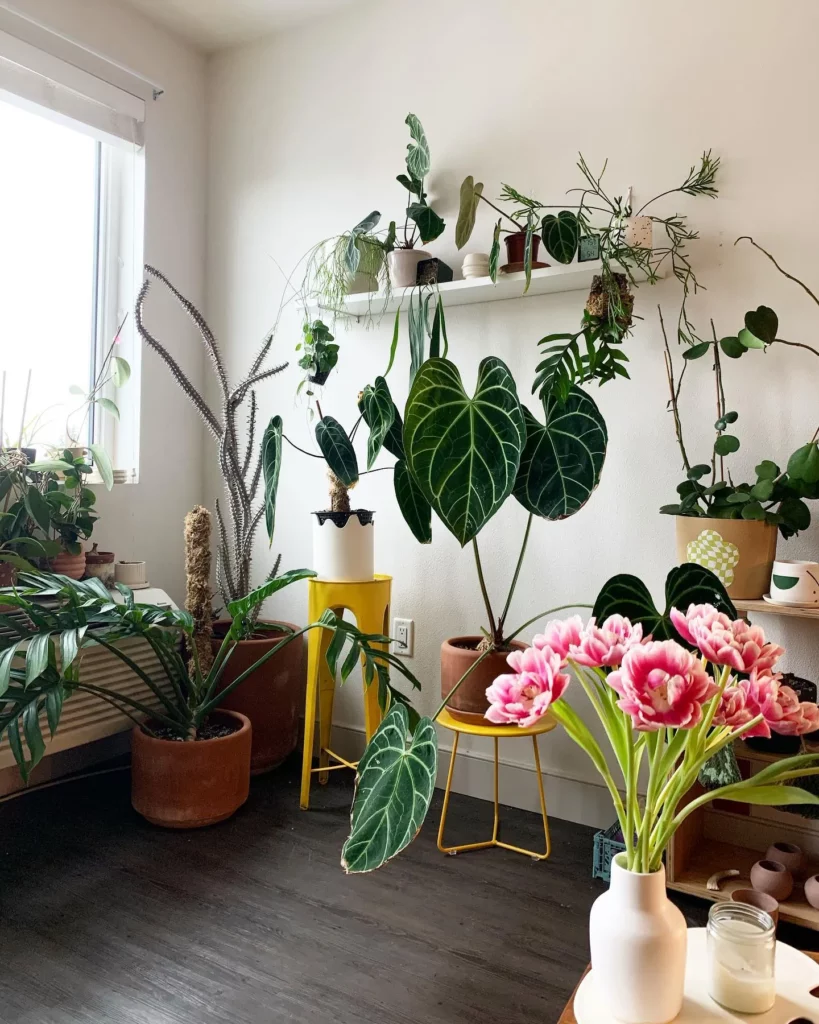
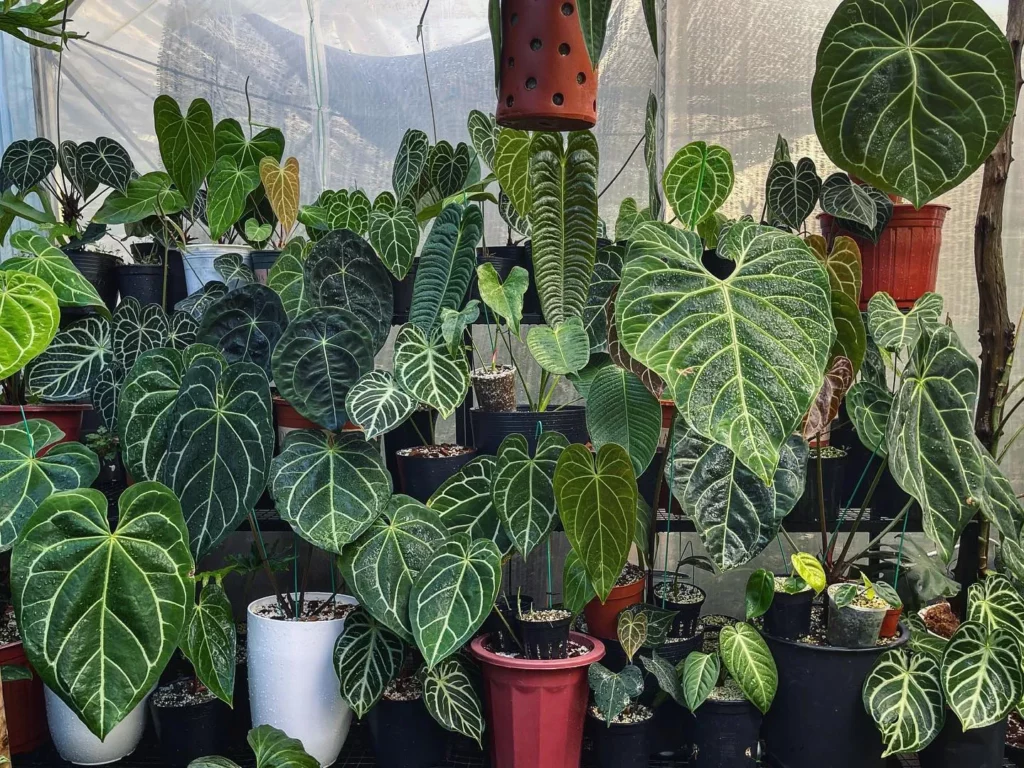

Anthurium magnificum is a stunning plant that belongs to the genus Anthurium and the family Araceae. This plant is commonly referred to as Magnificent Anthurium, and it’s not difficult to see why.
With its large, glossy green leaves and striking red flowers, this plant is truly magnificent. The genus Anthurium includes over 1000 species of plants, many of which are cultivated for their ornamental value.
Most Anthurium plants are native to Central and South America, where they grow in tropical rainforests. The name “Anthurium” comes from the Greek words “anthos” meaning flower and “oura” meaning tail, referring to the spadix or flowering spike that emerges from the center of each flower.
The species name for Magnificent Anthurium is magnificum, which means “magnificent” in Latin. This particular variety of Anthurium is highly sought after by enthusiasts due to its vibrant red flowers and large foliage.
The leaves of this plant can grow up to 3 feet long and are heart-shaped with prominent veins. Care Tips: When selecting an Anthurium for your home or garden, it’s important to choose a variety that will thrive in your specific climate conditions.
While most Anthuriums prefer warm temperatures and high humidity levels, some varieties can tolerate cooler temperatures or drier air. In addition to its stunning appearance, Magnificent Anthurium is also relatively low maintenance when it comes to care requirements.
Anthurium magnificum – Magnificent Anthurium Appearance

The Anthurium magnificum is a stunning plant that is native to Central and South America.
It is a member of the Araceae family and is known for its large, velvety leaves that are heart-shaped. The plant’s leaves can reach up to 3 feet in length, making it one of the largest species of anthurium available.
One of the most striking features of this plant is its leaf veins. They are thick and white, which contrasts beautifully with the deep green color of the leaves.
The veins also give the leaves a crinkled appearance, adding to their unique texture. Additionally, the plant produces tall yellow spathes that resemble flowers but are actually modified leaves.
When it comes to potting this beauty, I recommend using a large container that can accommodate its size because it can grow quite big when given proper care techniques. When choosing a potting mix for your Anthurium magnificum, go for one that drains well but retains moisture at the same time.
Care Tips: To maintain its beauty, make sure to keep it away from direct sunlight as it can cause sunburn on its delicate foliage. Place your Anthurium magnificum in bright indirect light instead; south or west windows are good spots for this plant.
Moving on to pruning, I personally only remove damaged or yellowing foliage when they appear; other than that I don’t like pruning as it will ruin the natural shape of my Anthurium magnificum’s foliage and overall look. Regarding propagation techniques – since division often causes shock to this species leading up sometimes up rotting on some parts- I suggest only dividing them every few years if they outgrow their container size significantly.
How To Grow Anthurium magnificum – Magnificent Anthurium
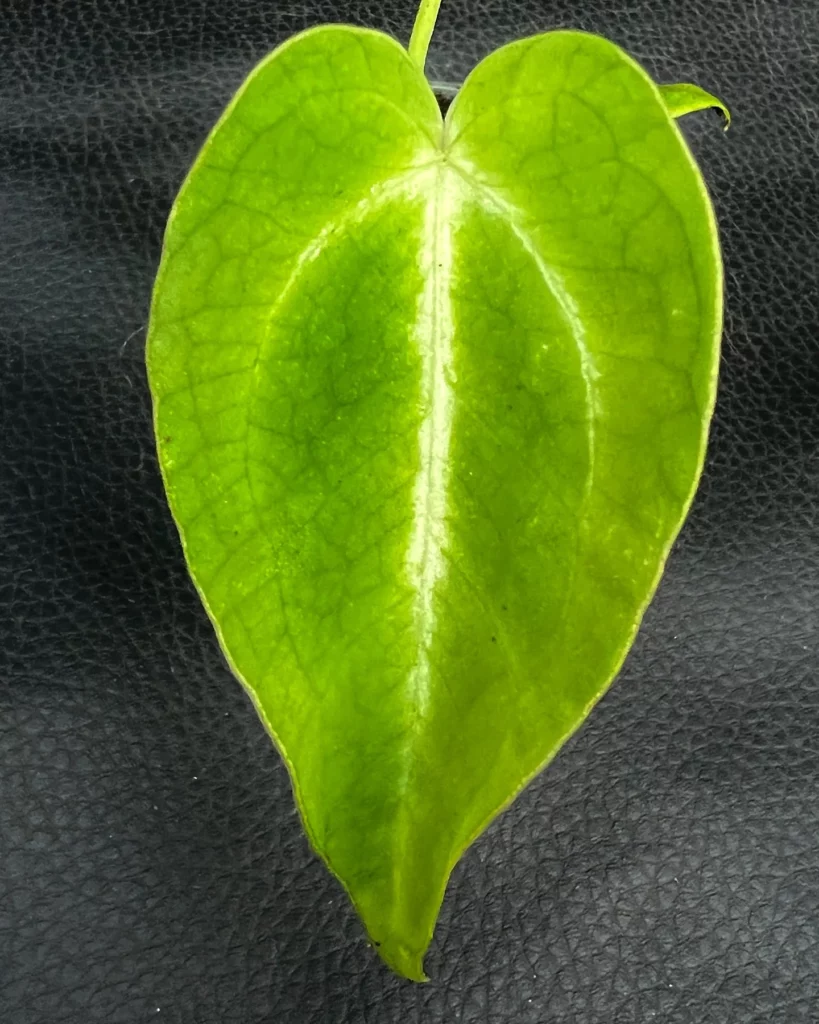

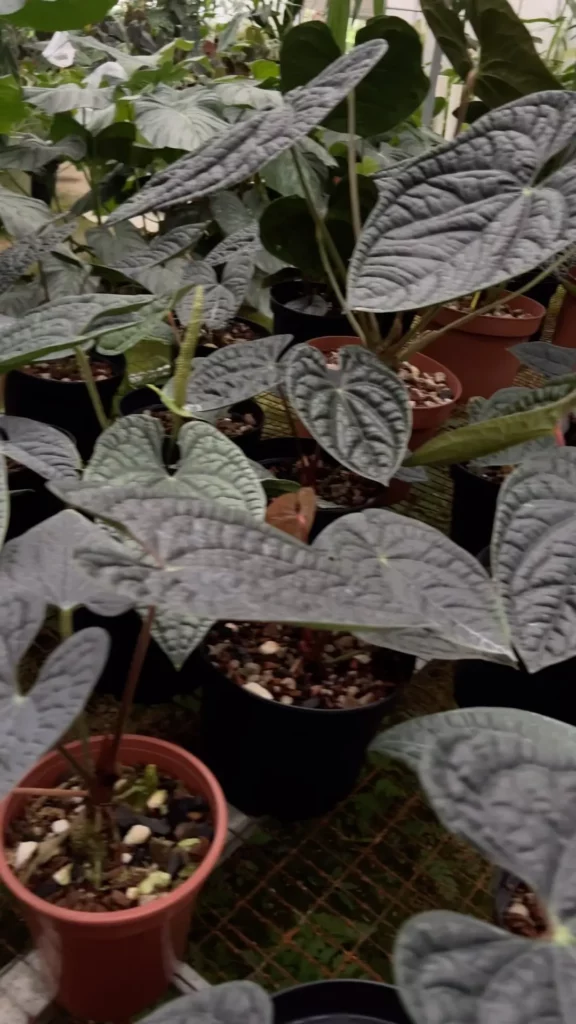
Growing Anthurium magnificum – Magnificent Anthurium can be an incredibly rewarding experience for any plant enthusiast. This tropical plant is a true stunner with its large, velvet-like leaves and unique, heart-shaped flowers.
But don’t be fooled by its beauty – this plant requires some specific care to thrive in your home. Firstly, let’s talk about where to grow your Anthurium magnificum.
This plant is native to Central and South America and thrives in warm, humid environments with filtered light. Care Tips: It’s important to keep the plant away from direct sunlight as it can burn the leaves.
Additionally, make sure the area is well-ventilated as too much stagnant air can cause mold growth. Next up – soil requirements.
Like most tropical plants, Anthurium magnificum prefers a well-draining soil mix that retains moisture without becoming waterlogged. A good mix would consist of peat moss, perlite, and orchid bark in equal parts.
Care Tips: Make sure the pot has drainage holes at the bottom to prevent root rot. When it comes to watering your Magnificent Anthurium, less is more!
Overwatering can be disastrous for this plant as it tends to prefer slightly drier conditions than other houseplants. Water only when the top layer of soil feels dry to the touch; usually once a week should suffice but adjust according to your environment and pot size.
Care Tips: Always use room temperature water as cold water can shock the roots. Let’s talk about fertilizing your beloved Anthurium magnificum.
This isn’t a particularly heavy feeder but will benefit from monthly feedings during its growing season (spring/summer). A balanced fertilizer mix with macro and micronutrients should do wonders for this plant’s growth and flowering abilities!
Care Tips: Be careful not to over-fertilize as this can lead to burnt roots and stunted growth. With some patience and care, growing Anthurium magnificum can be a rewarding experience that brings life and beauty into your home.
Anthurium magnificum – Magnificent Anthurium Propagation Tips
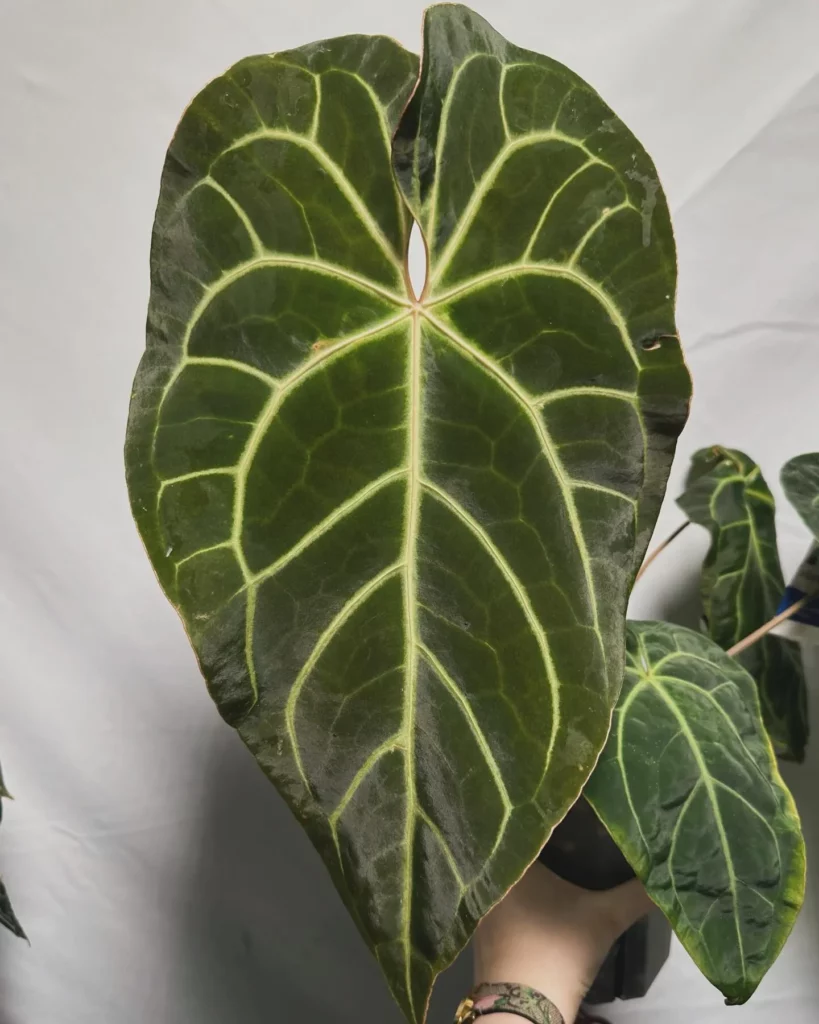
Anthurium magnificum – Magnificent Anthurium is not only an exotic addition to your plant collection but also a stunning centerpiece. And as with any beautiful plant, who wouldn’t want more of them?
The best way to get more Anthurium magnificum plants is through propagation. So, let’s dive into some of the best propagation tips for this magnificent species.
One of the easiest ways to propagate Anthurium magnificum – Magnificent Anthurium is through division. As you probably know, this plant grows by producing new shoots from its rhizome.
To propagate via division, simply separate these shoots from the parent plant and pot them separately. Care Tips: Be sure to use sterile tools and soil when doing this, and avoid injuring the parent plant’s roots.
Another popular method for propagating Anthurium magnificum – Magnificent Anthurium is via stem cuttings. Choose a healthy leaf with an attached stem and cut it off at the base.
Then make 2-3 inch long cuts on either side of where you removed the leaf from the stem; these will become your new plants’ roots! Dip each cutting in rooting hormone before planting it in moist soil or water until it sprouts new roots.
Care Tips: Keep a humid environment around the cuttings until they are established. If you want to avoid all that fuss, try growing your Anthurium magnificum – Magnificent Anthurium from seed!
This process requires patience since seeds take several weeks to germinate and need constant attention during their first few months of life. However, it can be very rewarding to watch your little babies grow up into full-grown plants!
Care Tips: Use high-quality seed-starting mixtures, keep temperatures steady at around 75°F (24°C), provide bright light but not direct sunlight. We must address tissue culture as an alternative option for propagating Anthurium magnificum – Magnificent Anthurium.
Although tissue culture is not a method that I personally recommend, it can produce large numbers of identical plants quickly and efficiently. However, it requires expensive equipment and expertise in sterile techniques.
Plus, the plants produced this way may not be as hardy as those grown from seed or cuttings.
Care Tips: If you decide to try tissue culture at home, be sure to follow all safety protocols carefully and invest in high-quality equipment and materials.
Anthurium magnificum – Magnificent Anthurium Quick Care Overview
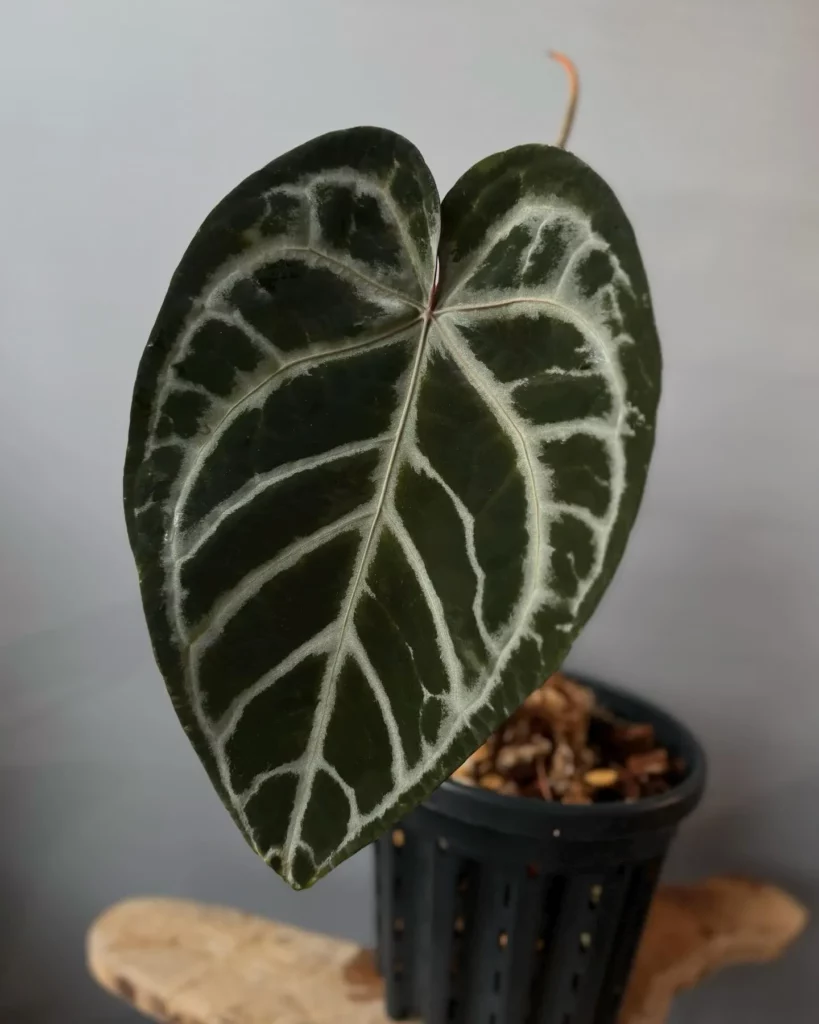

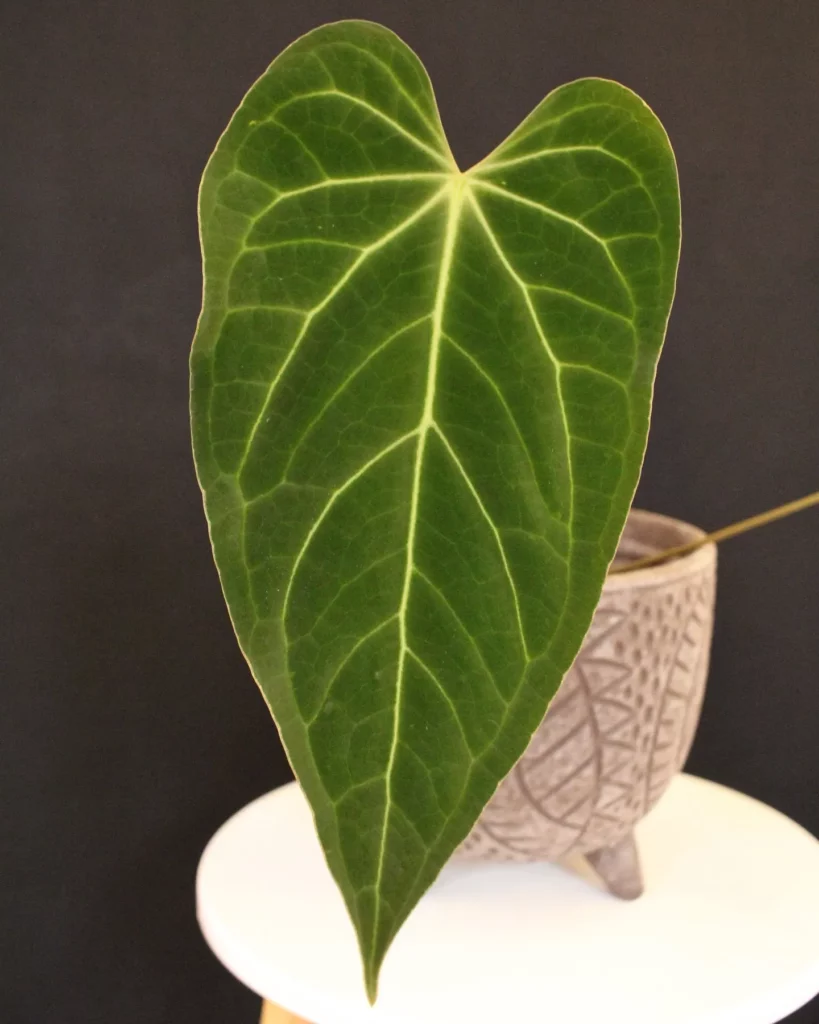
When it comes to Anthuriums, the Magnificent Anthurium (Anthurium magnificum) is a standout species. Native to Central and South America, this plant boasts large, dark green leaves that are heart-shaped and velvety to the touch. The leaves can grow up to 1.5 meters in length, making it an impressive addition to any plant collection.
But as with any houseplant, proper care is key if you want your Magnificent Anthurium to thrive. To start with the basics of caring for your Magnificent Anthurium, ensure that it is planted in well-draining soil.
These plants like their soil on the moist side but not waterlogged – so make sure your pot has drainage holes and don’t let water sit in a saucer under the pot.
Care Tips: A good rule of thumb is only watering when the top inch or so of soil feels dry.
When it comes to light requirements for your Magnificent Anthurium, bright but indirect light is best – think filtered sun through a sheer curtain or placed a few feet away from a sunny window. Direct sunlight can scorch those beautiful leaves!
Care Tips: If you notice yellowing or browning of leaves or leaf tips, move your plant further away from direct light. While these plants don’t require frequent fertilization, giving them some nutrients every few months can help them produce more blooms and grow larger leaves over time.
Use a balanced fertilizer – one with equal parts N-P-K (nitrogen-phosphorus-potassium).
Care Tips: Always dilute fertilizer according to package instructions before applying.
We have humidity requirements for your Magnificent Anthurium – they like moderately high humidity levels but can tolerate lower levels as well. Misting their leaves occasionally or placing them near other plants will help create some natural humidity around them if necessary.
Care tips: Consider investing in a small humidifier if your home is particularly dry, or placing a tray of pebbles and water near the plant to create a little extra humidity.
Anthurium magnificum – Magnificent Anthurium Light Requirements

Anthurium magnificum, or Magnificent Anthurium, is a beautiful tropical plant that features glossy green leaves and lovely white flowers. If you’re looking to grow this stunning houseplant, it’s essential to know about its light requirements.
In this section, we’ll discuss everything you need to know about providing adequate light to your Anthurium magnificum. The Magnificent Anthurium is known for its natural habitat in the tropical rainforests of Central and South America.
This means the plant enjoys bright indirect sunlight but prefers to avoid direct sunlight. Care Tips: Place your Anthurium magnificum in an east or west-facing window where it can get plenty of bright indirect light throughout the day.
If your only option is a south-facing window, consider moving the plant away from direct sunlight during the hottest part of the day. Conversely, if you don’t have access to a natural source of light, position your Magnificent Anthurium close to an artificial light source.
Care Tips: Use fluorescent grow lights or LED grow lights and keep them on for 12-14 hours per day. It’s important not to expose your Anthurium magnificum to too much direct sunlight because it can cause damage such as scorching or leaf burn.
In contrast, insufficient lighting can lead to stunted growth and fewer flowers. Therefore it’s crucial not only that your plant gets enough sunlight but also that you don’t overexpose it or keep it in complete darkness for too long periods.
Anthurium magnificum – Magnificent Anthurium Soil Requirements



When it comes to the soil requirements for Anthurium magnificum, let me tell you, there is nothing more important than getting this right.
The wrong type of soil can lead to a host of problems that will make you wish you never took on this plant in the first place. So, what kind of soil does this magnificent plant need?
First and foremost, the soil needs to be well-draining. This is non-negotiable.
If there’s one thing that Anthurium magnificum can’t stand, it’s soggy soil. This will lead to root rot and eventually kill your plant.
So please don’t make the mistake of using heavy clayey soils or potting mixtures that retain too much moisture. Next up is pH level – this needs to be slightly acidic for optimal growth.
A pH level between 5.5 and 6.5 is perfect for Anthurium magnificum’ s growth and development. One option for potting mix would be an equal blend of peat moss, perlite, and orchid bark chips which will provide excellent drainage while retaining enough moisture but not too much.
If you don’t want to make your own potting mix, another alternative would be a high quality all-purpose commercial potting mixture with added perlite or coarse sand mixed in to improve drainage. Care Tips: Whatever medium you choose (homemade or store-bought), ensure that it is free from pests and diseases before use as these can quickly spread once introduced into your indoor garden environment.
While some may choose cheap soils as a cost-cutting measure when growing plants indoors many times they regret later due to poor plant growth outcomes . Growing healthy plants requires high-quality inputs such as good soils which are well-draining yet retain sufficient moisture ensuring optimal health for your plants over time making it well worth the extra investment.
Anthurium magnificum – Magnificent Anthurium Potting and Repotting

When it comes to potting Anthurium magnificum, you have to be very careful. This is because these plants are very sensitive and if not handled properly, can experience significant stress.
When choosing the pot size, consider the current size of your plant and whether you want it to grow bigger or not. If you want it to grow bigger, choose a slightly larger pot with good drainage holes.
However, if you prefer to keep it small then go for a smaller-sized pot so as not to encourage growth. When repotting your Anthurium magnificum plant, make sure that the new container has enough space for the roots to spread out.
You don’t want them cramped up in a small place as this will only make matters worse. Before repotting your plant, water it well so that the soil becomes moist and easy to remove from the old container.
Once you have removed all the soil from around the root ball, gently tease out any tangled roots with your fingers. Care Tips: It is important that when planting Anthurium magnificum in a new container that you use fresh potting soil mixed with some perlite or sand for better drainage.
This helps in preventing soil compaction that can lead to root rot. After transplanting your Anthurium magnificum into its new home, water it thoroughly but be careful not to over-water as this can cause root rot or diseases such as fungal infections.
Pruning is another important aspect of caring for your Magnificent Anthurium plant during repotting. Make sure you remove any dead leaves or stems before placing them in their new home.
Pruning also helps stimulate new growth which is essential for maintaining healthy foliage and vibrant flowers. When potting and repotting Anthurium magnificum plants we need to choose the right size pot and avoid overcrowding the roots.
Additionally, use fresh potting soil and perlite or sand for better drainage, prune any dead leaves or stems and be careful not to over-water. These are all important care tips that will help you maintain a healthy Anthurium magnificum plant.
Anthurium magnificum – Magnificent Anthurium Pruning and Shaping

Pruning and shaping your Anthurium magnificum – Magnificent Anthurium is an essential part of its care. It helps maintain the plant’s health, promote growth, and improve its overall appearance. When it comes to pruning, there are a few things you need to keep in mind.
First, make sure you use clean and sharp tools. Dirty or dull equipment can damage the plant’s tissue or introduce harmful bacteria or fungi into the wounds.
Secondly, always cut at a 45-degree angle above a node or a leaf that’s facing outward. This will encourage new growth in the right direction and prevent water from accumulating on the cuts.
Now let’s talk about what to prune. Dead or yellow leaves should be removed promptly as they can become breeding grounds for pests and diseases.
You can also trim brown tips from healthy leaves if they bother you aesthetically, but it’s not necessary for the plant’s survival. When it comes to shaping your Anthurium magnificum – Magnificent Anthurium, you have two options: selective pruning or pinching.
Selective pruning involves removing entire stems or branches that are too long, weak, damaged, or misshapen. Pinching refers to nipping off the tips of new growth with your fingers to encourage bushier foliage.
Personally, I prefer selective pruning as it allows me more control over how my plant grows over time. However, pinching is also a viable option if you want a fuller look without sacrificing height.
Just keep in mind that too much pinching can stress out your plant and reduce its flower production over time. Pruning and shaping your Anthurium magnificum – Magnificent Anthurium is easy once you know what to do and why you’re doing it Care Tips.
Don’t be afraid to experiment with different methods until you find what works best for your particular plant and personal taste. As always though, remember to proceed with caution and take the necessary precautions to avoid causing any unnecessary damage.
Anthurium magnificum – Magnificent Anthurium Temperature Requirements
The Anthurium magnificum, as the name suggests, is an exquisite plant that demands an ideal temperature range to thrive.
This tropical plant loves warm and humid conditions and must be kept away from cold drafts at all times. It is vital to maintain a warm environment of about 68°F to 86°F (20°C to 30°C) for the Magnificent Anthurium species.
During winters, when temperatures can drop below the ideal range for this plant species, it’s essential to move them indoors or in a heated greenhouse. A sudden drop in temperature can lead to foliage yellowing and could cause permanent damage.
If you live in an area where temperatures fluctuate significantly, I recommend investing in a room thermometer or a digital hygrometer that measures the humidity levels of your plant’s environment. Care Tips: Avoid placing your Anthurium magnificum near AC vents or heating systems as this will interfere with its temperature requirements.
Humidity Requirements Anthurium magnificum thrives under high humidity conditions.
In their natural habitat, these plants grow on trees and rocks close to water sources that ensure high humidity levels. Therefore it is crucial always to keep both soil and air moisture levels high when growing this species indoors.
If you are struggling with keeping humidity levels up because of dry indoor air conditions, there are several ways you can boost it artificially such as: • Placing a bowl of water near your plants
• Misting your plants twice daily • Using humidifiers in the same room that your magnificent Anthurium is located
Care Tips: High relative humidity helps prevent spider mites and other pests from attacking your plants. Watering Anthurium magnificum – Magnificent Anthurium
Water is like lifeblood for any plant species; therefore, proper watering technique is critical for growing healthy magnificent Anthuriums. Remember to keep the soil moist but not waterlogged.
Overwatering your Anthurium magnificum can lead to root rot, which could cause permanent damage or even death. To prevent overwatering, I suggest watering your plant when the topsoil feels dry to the touch.
Ensure you use tepid water and pour it evenly over the soil surface without allowing it to touch foliage. Watering from below by placing your planter in a tray of water is also an excellent option for maintaining proper hydration levels.
Care Tips: If you see yellow foliage or brown tips on leaves, it could be a sign of under or over-watering. Adjust accordingly.
Fertilizing Anthurium magnificum – Magnificent Anthurium The Magnificent Anthurium is a heavy feeder and requires frequent fertilization to maintain healthy growth and development.
Fertilizing your plant once every month with an all-purpose liquid fertilizer during its growing season can make a significant difference in promoting lush foliage and vibrant blooms. Avoid using too much fertilizer, as it could burn the roots of your plant leading to stunted growth or even death.
Humidity Requirements
Anthurium magnificum – Magnificent Anthurium is an exotic plant that demands a specific environment to thrive. One of the critical environmental factors that influence its growth is humidity. As a tropical plant, Anthurium magnificum – Magnificent Anthurium loves high humidity levels, mimicking the humid conditions of its natural habitat in South America.
If you want to grow this beautiful plant successfully, you need to provide it with the right amount of moisture in the air. Care Tips: Make sure to keep your Anthurium magnificum – Magnificent Anthurium away from any air conditioning or heating vents since they can make the air too dry for your plant.
You can increase humidity levels near your plant by using a humidifier or placing a tray of water nearby. Another way to provide moisture is by misting your plant’s leaves regularly with lukewarm water.
In general, experts recommend maintaining relative humidity levels between 60-80% for optimal growth of Anthurium magnificum – Magnificent Anthurium. However, if you live in a dry climate, achieving such high levels can be challenging.
In such cases, it’s crucial to monitor and adjust humidity levels regularly as per your location and climatic conditions. Care Tips: A proper watering routine for your Anthurium magnificum – Magnificent Anthurium can also help maintain elevated humidity levels around it.
When watering your plant, make sure not to overwater and avoid letting water sit in the pot’s saucer for too long as it can lead to root rot and other issues. It’s worth noting that high humidity doesn’t necessarily mean excessively damp soil; all plants need their roots to breathe properly.
Therefore it’s essential always to check soil moisture before watering and ensure adequate drainage for healthy root development. Providing adequate humidity is crucial for successful cultivation of Anthurium magnificum – Magnificent Anthurium.
Watering Anthurium magnificum – Magnificent Anthurium
Proper watering is crucial to keep your Anthurium magnificum healthy and happy.
This tropical plant needs consistent moisture, but not too much. Overwatering can cause root rot and other fungal diseases that are hard to get rid of once they begin.
On the other hand, underwatering can lead to dehydration, wilting leaves, and eventually death. Care Tips: When it comes to watering your Magnificent Anthurium, always check the soil moisture level before watering it again.
Stick your finger into the soil about an inch deep and if the soil feels dry at that depth, water your plant thoroughly until water flows out from the drainage holes in the pot. Ensure that there’s no standing water in the saucer because this can lead to root rot.
Anthurium magnificum prefers a consistent level of moisture rather than drought followed by a flood of water. Water slightly less frequently during winter months when light levels are low, and temperatures are cooler compared to summers when light levels are high.
It’s vital always to use room temperature or lukewarm water for irrigation since cold tap water can shock or harm roots leading to stress on plants. To increase humidity levels around plants try misting them regularly using filtered or distilled water.
Fertilizing Anthurium magnificum – Magnificent Anthurium
One of the essential aspects of Anthurium magnificum – Magnificent Anthurium care is fertilizing. These plants require proper nutrients to grow and bloom, and fertilizing helps them achieve optimal health.
However, not all fertilizer options are equal, and you need to understand what works best for your Anthurium magnificum plant. When it comes to fertilizing Anthurium magnificum plants, organic fertilizer is the best option.
Organic fertilizer provides a steady supply of nutrients over an extended period while improving soil fertility naturally. It offers vital macronutrients like nitrogen (N), phosphorus (P), and potassium (K), plus micronutrients like iron (Fe), zinc (Zn), boron (B), magnesium (Mg) essential for healthy plant growth.
Another critical factor when fertilizing your Anthurium magnificum is timing. Fertilizers should get applied every four to six weeks during the growing season from spring through summer.
Consider reducing fertilizer applications during winter since plants slow down growth and go dormant. While using organic fertilizer has its benefits, avoid over-fertilization at all costs.
Over-fertilization can cause salt buildup in the soil leading to root damage or nutrient deficiency in worse cases. Care Tips: Always follow package instructions when applying organic fertilizer.
A crucial tip when choosing a fertilizer brand for your Anthurium magnificum is selecting a slow-release formula designed explicitly for indoor houseplants’ needs. Several brands offer specially formulated slow-release pellets that release nutrients gradually over time, ensuring your plant receives consistent nutrition without risking over-fertilization or nutrient burn.
Pest Control Tips for Anthurium magnificum – Magnificent Anthurium
There’s no denying that pests can be a real pain when it comes to keeping your Anthurium magnificum thriving.
From spider mites to mealybugs, there are all kinds of critters that can wreak havoc on these magnificent plants. But fear not – with the right pest control measures in place, you can keep your Anthurium magnificum healthy and beautiful.
First on the list of pest control tips for Anthurium magnificum is to keep a close eye on your plant. Regularly inspecting your plant for signs of pests is crucial for catching problems early on before they become too serious.
Look out for any sticky residue or black sooty mold, which could be a sign of an infestation. If you do spot any pests on your Anthurium magnificum, there are a few different approaches you can take to get rid of them.
One option is to use an insecticidal soap or oil spray. These products work by suffocating insects and their eggs, making them an effective way to control many common pests.
Another option is to introduce natural predators into your home or greenhouse. Ladybugs and lacewings are two examples of beneficial insects that will happily gobble up many types of garden pests.
If you’re dealing with a particularly stubborn infestation, however, you may need to resort to chemical pesticides. When it comes to pest control for Anthurium magnificum (or any other houseplant), prevention is always better than cure.
To help keep pests at bay, make sure you’re following proper care tips like maintaining the right humidity levels and watering as needed (not too much!). Additionally, avoid overcrowding plants as this can create ideal conditions for unwanted bugs and mites.
Anthurium magnificum – Magnificent Anthurium Common Problems
Are you dealing with droopy leaves, yellowing foliage, or brown spots on your Anthurium magnificum? Don’t worry; you are not alone!
Many plant enthusiasts struggle with the common problems that can plague this magnificent houseplant. In this section of the article, we will discuss some of the most common issues and how to solve them.
One of the most prevalent problems with Anthurium magnificum is root rot. This issue can occur due to overwatering or poor drainage, and it can be fatal if not addressed promptly.
To avoid root rot, make sure you are using well-draining soil and a pot with drainage holes. It is crucial to allow the top inch of soil to dry out between watering.
Care Tips: If you notice any signs of root rot, such as wilting leaves or a foul odor from the soil, remove your plant from its pot and trim away any affected roots before repotting in fresh soil. Another issue that many people encounter is pests such as spider mites and mealybugs.
These tiny insects can be hard to spot but can cause significant damage if left unchecked. To keep your Anthurium magnificum pest-free, regularly inspect your plant for any signs of infestation.
Care Tips: If you do detect pests on your plant, treat them immediately with a mild insecticide soap or neem oil spray. Brown leaf tips are another problem that many Anthurium magnificum owners experience.
This condition usually occurs when there is too little humidity in the air around your plant. To combat this issue, try misting your plant regularly or placing it near a humidifier or pebble tray filled with water.
Care Tips: Avoid placing your Anthurium magnificum near drafts or heating vents as this can also cause dry air conditions. Yellowing foliage can be a sign of a few different issues, including too much or too little light, overwatering, or nutrient deficiencies.
Care Tips: Check the soil moisture and adjust your watering schedule accordingly. If your plant is not getting enough light, consider moving it to a brighter location.
Frequently Asked Questions
To take care of Anthurium magnificum, provide it with bright, indirect light or filtered sunlight. Keep the soil consistently moist but not soggy, and maintain a high humidity level around the plant. Additionally, ensure the temperature remains within the range of 65-80°F (18-27°C) for optimal growth.
Anthurium magnificum thrives in bright, indirect light. It benefits from being placed near a window with filtered sunlight or in a well-lit room. Avoid exposing it to direct sunlight, as it can scorch the leaves.
Anthurium magnificum is known for its impressive leaf size and can grow to be quite large. Mature plants can reach a height of 2-3 feet (60-90 cm) with leaves spanning up to 1-2 feet (30-60 cm) in length. The plant’s size and growth rate can vary depending on environmental conditions and care provided.
Yes, Anthurium magnificum is generally considered a slow grower. It takes time for the plant to establish its roots and develop new leaves. Patience is required when growing this species, as it may take several months or even years to see significant growth and the emergence of new foliage.
After reading this, check out our other articles on:
Conclusion
Anthurium magnificum is a stunning plant that requires some effort to maintain. But the rewards of growing this magnificent Anthurium far outweigh the initial work required.
With proper care and attention, it will grow into an impressive display of beauty in your home or office. It’s important to keep in mind that Anthurium magnificum requires specific environmental conditions to thrive.
These include bright but indirect light, high humidity levels, and well-draining soil. Additionally, you should make sure to keep it away from drafty areas or extreme temperature changes.
One of the most crucial care tips for Anthurium magnificum is proper watering. It’s essential not to let the soil dry out completely or become waterlogged.
Instead, aim for consistently moist soil without overwatering. Another factor that contributes significantly to its growth is fertilizer choices and frequency.
It’s best to use a balanced fertilizer every few months during its growing season for optimal results. One of the most significant advantages of growing Anthurium magnificum is that it can purify your indoor air quality by removing harmful toxins such as formaldehyde and ammonia from the environment.
If you’re willing to put in the effort required, taking care of an Anthurium magnificum can be a rewarding experience both aesthetically and beneficially for your health. By following these care tips closely, you’ll be rewarded with a breathtaking plant that will uplift your space with its beauty and function as a natural air filter too!

